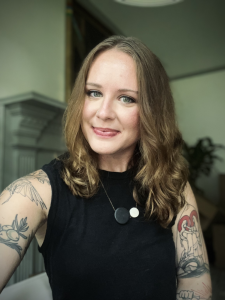 As we near the end of Women’s History Month, the ECL is proud to highlight the outstanding work of graduate students engaging with women’s and gender studies. Among these emerging scholars is Emily Waller Singeisen, a first year doctoral student and teaching fellow researching how ancient texts and their reception can inform contemporary gender & queer theory and, likewise, how this theory might enrich our readings of ancient texts. Her published work has examined the formation of gendered subjectivity in the ancient novel through the framework of Freud’s female Oedipus complex, and she continues to use psychoanalysis as a framework for theorizing gendered subjectivity.
As we near the end of Women’s History Month, the ECL is proud to highlight the outstanding work of graduate students engaging with women’s and gender studies. Among these emerging scholars is Emily Waller Singeisen, a first year doctoral student and teaching fellow researching how ancient texts and their reception can inform contemporary gender & queer theory and, likewise, how this theory might enrich our readings of ancient texts. Her published work has examined the formation of gendered subjectivity in the ancient novel through the framework of Freud’s female Oedipus complex, and she continues to use psychoanalysis as a framework for theorizing gendered subjectivity.
Learn more about Singeisen’s research interests below:
“My current research examines privately printed illustrated English translations of banned literature from Greco-Roman antiquity, including titles such as The Golden Ass, Mimes of the Courtesans, and Daphnis and Chloe. By studying the transmission of these texts, I intend to highlight the way in which the publications stage an alternate dialogue on sexuality—and the history of sexuality. In so doing, they also facilitate an alternate discursive community in the first part of the twentieth century amongst those who saw nonnormative and taboo sexual expression reflected in the canon of ancient literature.
“Two illustrators from the 1920s that have been particularly inspiring in my work are Clara Tice and the little-known Charles Cullen. Known as the ‘Queen of Greenwich Village,’ Tice illustrated a number of privately published erotic books, including Pierre Louys’ lesbian poetry, ‘Songs of Bilitis,’ Voltaire’s Candide, and Gautier’s Mademoiselle de Maupin. She was targeted insistently by Anthony Comstock for the so-called obscenity of her work, but she responded to threats of censorship with a playful defiance that has made her a particular favorite in my research. I have also been captivated by Charles Cullen’s illustrations for Mimes of the Courtesans. Cullen worked with translator A.L. Hillman on the project, and, both queer men in New York in the 1920s, they used the edition as an opportunity to insist on the beauty of “natural” sexual desires and the prevalence of queer love in the ancient world.
“As a queer woman, the research I do is not only intellectual but also deeply personal—feminist and queer theory is about a liberatory politics that extends beyond the ivory tower, and I intend to contribute to that liberation with all of my research and writing. While my research straddles both literary studies and the visual arts, I am always drawn to creating projects that span these disciplines and mobilize my research in the communities I am a part of. Last year, through a microgrant from the Society for Classical Studies, I had the privilege of working with my sister, who is an artist and activist against sexual violence, on the project ‘Mythic Women, Modern Incarnations.’ The project was a guerilla art installation combining sculptures inspired by mythic women with feminist receptions of the myths to raise awareness of the emancipatory potential of classical imagery.”

